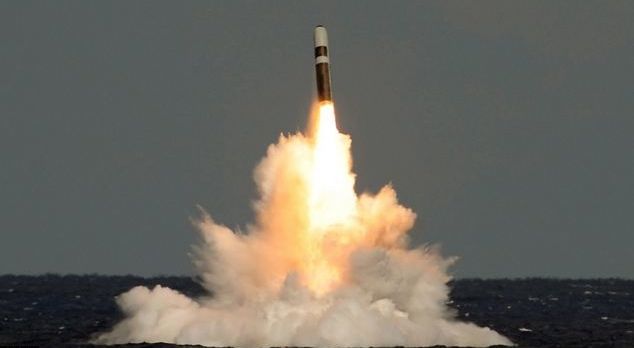
Test of a Navy Trident D5 submarine-launched ballistic missile.
WASHINGTON: In theory, the Navy and the Air Force could save money and reduce risk by using common, proven components on both services’ nuclear missiles. In practice, Air Force decisions in the coming months will “make or break the effective implementation of commonality,” said Vice Adm. Terry Benedict, head of the Navy Strategic Systems Programs.
“I believe now is the time to pursue intelligent commonality,” Benedict told a Peter Huessy breakfast this morning. “Having said, that I have concerns for where the overall commonality effort is going.”

Vice Adm. Terry Benedict
Over the winter, a study group provided detailed data on over 40 potential technologies to share, from rocket nozzles to radiation-hardened electronics to software. Benedict has recommended the Air Force make commonality a criterion in awarding Technical Maturity & Risk Reduction work on the replacement for the venerable Minuteman ICBM, the Ground-Based Strategic Deterrent. A formal Request for Proposals is expected this summer. (In Pentagonese, that would be a GDSB TMRR RFP). Now, said Benedict, it’s up to the Air Force.
The two services have developed their missiles separately in the past, and for good reason: Launching out of a silo underground is very different from launching out of a submarine underwater. Land-based ICBM design emphasizes accuracy and rapid response. Submarine-Launched Ballistic Missiles (SLBMs) are inherently less accurate but can hide from a first strike underwater and then retaliate.
The services also face different challenges because of the different ages of their missiles. The Air Force wants to replace its aging Minuteman altogether but is still in very early stages, given that it’s not even kicked off the competition for technology maturation contracts. The Navy plans on keeping its Trident D5 for decades to come, serving on both the current Ohio class submarines and on the successor Ohio Replacement Program entering service in the 2030s. Only then will the Navy field a new nuclear missile.

Minuteman III in silo
That timeline “more than doubles the historical service life of any previous sea-based strategic deterrent system,” Benedict noted, which makes replacing aging components essential. The Trident D5 Life Extension refurbishes the W76 and W88 warheads (aka “reentry systems”) and many other components. Testing is well underway and the first operational missiles enter the fleet in a few months, with Initial Operational Capability (IOC) in 2017.
The 40-plus technologies identified as possible places to seek commonality with the Air Force spin off from Trident life extension work, said Benedict.
Will designing the next missile submarine to use the Trident tie the Navy’s hands on its eventual future missile? “It won’t,” Benedict told reporters after the breakfast talk. A tube big enough to hold a Trident D5 is plenty roomy for a wide range of options, including multiple smaller missiles if desired. “I can’t make it bigger,” he said. “I can make them smaller.”
Production on those missiles tubes has already begun, in close conjunction with the British: The Royal Navy‘s future SSBN will use not only the same tubes but an entire Common Missile Compartment that’s interchangeable with those on the Ohio Replacement.
Does Britain’s vote to exit the European Union (but not NATO) potentially disrupt the 52-year US-UK collaboration on nuclear missile submarines? “I have no concerns,” Benedict said. “I think that was a decision based on its relationship … with Europe and the EU, not its relationship with the United States.”
GD chief says Navy’s 1 sub buy won’t impact company short term, but out years less certain
The comments from the General Dynamics chief come on the same day President Joe Biden signed the national security supplemental, which includes billions for the sub industrial base.



























